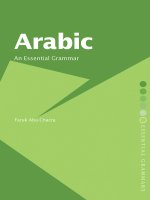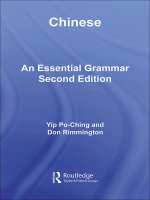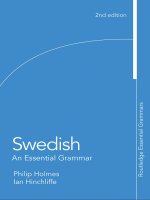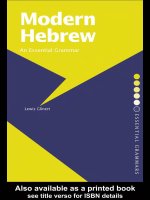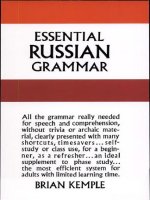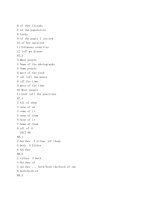Portuguese essential grammar
Bạn đang xem bản rút gọn của tài liệu. Xem và tải ngay bản đầy đủ của tài liệu tại đây (2.42 MB, 283 trang )
1111
2
3
4
5
6
7
8
9
1011
1
12111
3
4
5
6
7
8
9
20111
1
2
3
4
5
6
7
8
9
30111
1
2
3
4
5
6
7
8
9
40
41111
Portuguese
An Essential Grammar
Second Edition
This new edition of Portuguese: An Essential Grammar is a practical reference guide to the most important aspects of modern Portuguese.
It presents a fresh and accessible description of the language that combines
traditional and function-based grammar. The book sets out the complexities of Portuguese in short, readable sections. Explanations are clear and
free from jargon. Throughout, the emphasis is on Portuguese as used by
native speakers around the world.
The Grammar is the ideal reference source for the learner and user of
Portuguese. It is suitable for either independent study or for students in
schools, colleges, universities and adult classes of all types.
This second edition features:
•
•
•
•
•
Coverage of both European and Brazilian Portuguese and information
on the lexical differences between the two
Detailed contents list and index for easy access to information
Full use of authentic examples
Coverage of traditional grammar and language functions
New section on the history and culture of the Portuguese-speaking
world
Amélia P. Hutchinson is Supervisor for Portuguese Language at the
University of Georgia and Janet Lloyd is Lecturer in Portuguese and
Spanish at the University of Salford.
Routledge Essential Grammars
Essential Grammars are available for the following languages:
Chinese
Danish
Dutch
English
Finnish
Modern Hebrew
Norwegian
Polish
Portuguese
Swedish
Urdu
Other titles of related interest published by Routledge:
Colloquial Portuguese
By João Sampaio and Barbara McIntyre
Colloquial Portuguese of Brazil
By Esmenia Simões Osborne, João Sampaio and Barbara McIntyre
1111
2
3
4
5
6
7
8
9
1011
1
12111
3
4
5
6
7
8
9
20111
1
2
3
4
5
6
7
8
9
30111
1
2
3
4
5
6
7
8
9
40
41111
1111
2
3
4
5
6
7
8
9
1011
1
12111
3
4
5
6
7
8
9
20111
1
2
3
4
5
6
7
8
9
30111
1
2
3
4
5
6
7
8
9
40
41111
Portuguese
An Essential Grammar
Second Edition
Amélia P. Hutchinson and
Janet Lloyd
First edition published 1996
by Routledge
29 West 35th Street, New York, NY 10001
Simultaneously published in the UK
by Routledge
11 New Fetter Lane, London EC4P 4EE
Reprinted 1997, 1999, 2000, 2002
Second edition published 2003 by Routledge
Routledge is an imprint of the Taylor & Francis Group
© 2003 Amélia P. Hutchinson and Janet Lloyd
This edition published in the Taylor & Francis e-Library, 2006.
“To purchase your own copy of this or any of Taylor & Francis or Routledge’s
collection of thousands of eBooks please go to www.eBookstore.tandf.co.uk.”
All rights reserved. No part of this book may be reprinted or
reproduced or utilised in any form or by any electronic, mechanical,
or other means, now known or hereafter invented, including
photocopying and recording, or in any information storage or
retrieval system, without permission in writing from the publishers.
British Library Cataloguing in Publication Data
A catalogue record for this book is available from the British Library.
Library of Congress Cataloging-in-Publication Data
Hutchinson, Amélia P., 1949–
Portuguese: an essential grammar/Amélia P. Hutchinson and
Janet Lloyd. – 2nd ed.
p. cm. – (Routledge essential grammars)
Includes bibliographical references and index.
1. Portuguese language – Grammar. 2. Portuguese language –
Textbooks for foreign speakers – English. I. Lloyd, Janet, 1968–
II. Title. III. Series.
PC5067.3.H88 2003
469.82′421–dc21
2003005266
ISBN 0-203-42656-8 Master e-book ISBN
ISBN 0-203-44077-3 (Adobe eReader Format)
ISBN 0-415-30816-X (hbk) (Print Edition)
1111
2
3
4
5
6
7
8
9
1011
1
12111
3
4
5
6
7
8
9
20111
1
2
3
4
5
6
7
8
9
30111
1
2
3
4
5
6
7
8
9
40
41111
1111
2
3
4
5
6
7
8
9
1011
1
12111
3
4
5
6
7
8
9
20111
1
2
3
4
5
6
7
8
9
30111
1
2
3
4
5
6
7
8
9
40
41111
Contents
Foreword to first edition
Acknowledgments
Foreword to second edition
How to use this book
xiv
xvi
xviii
xx
PART I: AN ESSENTIAL GRAMMAR
1
Chapter 1 Pronunciation and spelling
3
1.1
1.2
1.3
1.4
1.5
Vowels
Consonants
Diphthongs
Stress
Accents
Chapter 2 Nouns
2.1
2.2
2.3
2.4
2.5
2.6
Gender I: masculine and feminine
Gender II: forming the feminine
Number: forming the plural
Diminutives and augmentatives
Compound nouns
Collective nouns
Chapter 3 Articles
3.1
3.2
3.3
3.4
Definite article
Use of the definite article
Omission of the definite article
Contraction of the definite article
3
4
6
7
8
9
9
11
15
18
21
22
24
24
24
25
27
v
Contents
3.5
3.6
3.7
3.8
Indefinite article
Use of the indefinite article
Omission of the indefinite article
Contraction of the indefinite article
Chapter 4 Adjectives
4.1
4.2
4.3
4.4
4.5
Gender
Number
Degree
Agreement
Position in the sentence
Chapter 5 Pronouns
5.1
5.2
5.3
5.4
5.5
5.6
Personal pronouns
Possessive pronouns and adjectives
Demonstrative pronouns
Relative pronouns
Interrogative pronouns
Indefinite pronouns and adjectives
Chapter 6 Numerals
6.1
6.2
6.3
6.4
Cardinal, ordinal and multiplicative numbers
Collective numerals
Use of the conjunction e with numerals
Roman numerals
Chapter 7 Verbs
7.1
7.2
7.3
7.4
7.5
7.6
7.7
vi
7.8
7.9
Moods and tenses
Indicative mood
Subjunctive mood
Imperative mood
Infinitive
Present participle
Compound infinitive and compound present
participle
Past participle
Passive voice
28
29
30
30
32
32
34
36
40
41
43
43
53
55
57
60
62
64
64
66
66
67
68
68
69
82
90
91
93
94
94
95
1111
2
3
4
5
6
7
8
9
1011
1
12111
3
4
5
6
7
8
9
20111
1
2
3
4
5
6
7
8
9
30111
1
2
3
4
5
6
7
8
9
40
41111
1111
2
3
4
5
6
7
8
9
1011
1
12111
3
4
5
6
7
8
9
20111
1
2
3
4
5
6
7
8
9
30111
1
2
3
4
5
6
7
8
9
40
41111
7.10
7.11
7.12
7.13
Auxiliary verbs
Impersonal, unipersonal and defective verbs
Reflexive verbs
Changing vowel sounds in verbal conjugation
Chapter 8 Adverbs
8.1
8.2
8.3
8.4
8.5
98
103
104
106
107
Uses of the adverb
Adverbs in -mente
Other adverbs
Position
Degree
107
108
109
109
110
Chapter 9 Conjunctions
111
9.1
9.2
Co-ordinating conjunctions
Subordinating conjunctions
Chapter 10 Prepositions
10.1
10.2
10.3
10.4
Most commonly used prepositions
Prepositional phrases
Contraction of preposition + article or pronoun
Verbs followed by a preposition
Chapter 11 Additional notes on Portuguese usage
11.1
11.2
11.3
11.4
11.5
11.6
11.7
11.8
11.9
11.10
11.11
11.12
11.13
Gente/a gente
Tudo/todo
Por/para
A/para
Desde . . . até/de . . . a
Próximo/seguinte
Tão/tanto
Affirmative/negative
Ainda/já
Prepositions of time
Prepositions with means of transport
Word order
Ser/estar
Contents
111
113
116
116
116
117
117
119
119
119
120
121
121
122
122
123
123
124
124
125
128
vii
Contents
PART II: LANGUAGE FUNCTIONS
Chapter 12 Socializing
12.1
12.2
12.3
12.4
12.5
12.6
12.7
12.8
12.9
12.10
12.11
12.12
12.13
General greetings
Taking leave
Greeting/taking leave according to time of day
Attracting attention
Seasonal greetings
Personal greetings
Congratulations
Good wishes
Introductions
Forms of address
Talking about one’s health
Places and locations
Talking about the weather
Chapter 13 Exchanging factual information
13.1
13.2
13.3
13.4
13.5
13.6
Identifying people
Identifying things
Asking for information
Reporting, describing and narrating
Letter writing
Correcting assumptions
Chapter 14 Getting things done
14.1
14.2
14.3
14.4
14.5
14.6
14.7
14.8
14.9
Suggesting a course of action
Offering to do something
Requesting others to do something
Inviting others to do something
Asking for and giving advice
Warning others
Instructing others to do/not to do something
Requesting assistance
Stating and finding out whether something is
compulsory
14.10 Seeking, giving, refusing permission
viii
131 1111
133
133
134
135
136
138
138
138
139
139
140
144
146
148
151
151
154
155
157
160
163
165
165
166
166
167
167
168
169
170
171
172
2
3
4
5
6
7
8
9
1011
1
12111
3
4
5
6
7
8
9
20111
1
2
3
4
5
6
7
8
9
30111
1
2
3
4
5
6
7
8
9
40
41111
1111
2
3
4
5
6
7
8
9
1011
1
12111
3
4
5
6
7
8
9
20111
1
2
3
4
5
6
7
8
9
30111
1
2
3
4
5
6
7
8
9
40
41111
14.11 Expressing and finding out about need
14.12 Enquiring and expressing intention, want or desire
172
173
Chapter 15 Finding out and expressing intellectual
attitudes
175
15.1
15.2
15.3
15.4
15.5
15.6
15.7
Agreement and disagreement
Knowing something or someone
Remembering something or someone
Possibility and impossibility
Logical conclusions
Incomprehension and clarification
Certainty and uncertainty
Chapter 16 Judgement and evaluation
16.1
16.2
16.3
16.4
16.5
16.6
16.7
16.8
16.9
16.10
16.11
16.12
16.13
16.14
16.15
16.16
16.17
16.18
16.19
16.20
Expressing pleasure or liking
Expressing displeasure or dislike
Enquiring about pleasure/displeasure, liking/dislike
Enquiring about and expressing interest/lack of
interest
Expressing surprise
Expressing hope
Enquiring about and expressing satisfaction/
dissatisfaction
Expressing disappointment
Enquiring about and expressing worry or fear
Enquiring about and expressing preference
Expressing gratitude
Expressing sympathy
Expressing happiness and unhappiness
Apologizing
Enquiring about and expressing approval/disapproval
Expressing appreciation
Expressing regret
Expressing indifference
Accusing
Enquiring about and expressing capability/
incapability
Contents
175
177
178
179
181
182
183
185
185
186
187
188
189
190
191
192
192
194
194
195
196
196
197
198
199
200
200
201
ix
Contents
PART III: BRAZILIAN VARIANTS
Chapter 17 Brazilian essential grammar and
language functions
205
Chapter B1 Pronunciation and spelling
206
B1.1
B1.1.1
B1.2
B1.3
B1.3.2
Vowels
Oral vowels
Consonants
Diphthongs
Nasal diphthongs
Chapter B2 Nouns
B2.4
B2.4.1
B2.4.3
Diminutives and augmentatives
Diminutives
Preferred diminutives
Chapter B3 Articles
B3.2
B3.2.1
B3.2.2
B3.2.5
Use of the definite article
With first names
With titles
Before possessive adjectives
Chapter B4 Adjectives
B4.1.1.2
B4.3
B4.3.1
B4.3.3
Adjectives ending in -eu
Degree
The comparative
Special comparative and superlative forms
Chapter B5 Pronouns
x
203 1111
B5.1
B5.1.1
B5.1.2
B5.1.3
B5.1.5
B5.1.6
Personal pronouns
Subject pronouns
Direct object pronouns
Indirect object pronouns
Prepositional pronouns
Reflexive pronouns
208
208
209
209
209
210
210
210
210
211
211
211
211
211
212
212
212
212
212
213
213
213
213
215
215
216
2
3
4
5
6
7
8
9
1011
1
12111
3
4
5
6
7
8
9
20111
1
2
3
4
5
6
7
8
9
30111
1
2
3
4
5
6
7
8
9
40
41111
1111
2
3
4
5
6
7
8
9
1011
1
12111
3
4
5
6
7
8
9
20111
1
2
3
4
5
6
7
8
9
30111
1
2
3
4
5
6
7
8
9
40
41111
B5.2
B5.2.1
B5.2.2
Possessive pronouns and adjectives
Possessive adjectives
Possessive pronouns
Chapter B6 Numerals
B6.1
Cardinal, ordinal and multiplicative numbers
Chapter B7 Verbs
B7.4
B7.4.1
B7.6
B7.12
Imperative mood
Conjugation
Present participle
Reflexive verbs
Chapter B10 Prepositions
B10.4
Verbs followed by a preposition
Chapter B11 Additional notes on Brazilian
Portuguese usage
B11.1
B11.4
B11.11
B11.12
B11.12.1
B11.12.5
Gente/a gente
A/para
Prepositions with means of transport
Word order
Pronouns and verbs
Adverbs
Chapter B12 Socializing
B12.1
B12.1.1
B12.2
B12.2.1
B12.2.2
B12.4
B12.4.3
B12.10
B12.10.2
B12.10.3
General greetings
Informal
Taking leave
Informal
More formal farewells, figurative
Attracting attention
Call for help
Forms of address
Less informal
Formal
216
217
217
Contents
218
218
219
219
219
219
219
221
221
222
222
222
222
223
223
223
224
224
224
224
224
225
225
225
225
226
227
xi
Contents
B12.10.4
B12.10.5
B12.11
B12.11.1
B12.12.4
B12.13
Titles
Family
Talking about one’s health
In small talk and greetings
Place of residence and addresses
Talking about the weather
Chapter B13 Exchanging factual information
B13.1
B13.1.4
B13.3
B13.5
B13.5.1
B13.5.2
Identifying people
Profession, occupation
Asking for information
Letter writing
Dates
Opening formulas
Chapter B14 Getting things done
B14.4
B14.8
B14.12
230
230
230
230
231
231
231
232
Inviting others to do something
Requesting assistance
Enquiring about and expressing intention,
want or desire
233
Chapter B15 Finding out about and expressing
intellectual attitudes
234
B15.6
B15.7
232
232
Incomprehension and clarification
Certainty and uncertainty
234
234
Chapter B16 Judgement and evaluation
235
B16.2
B16.5
B16.6
B16.14
B16.17
xii
227
228
228
228
229
229
Expressing displeasure or dislike
Expressing surprise
Expressing hope
Apologizing
Expressing regret
235
235
235
236
236
1111
2
3
4
5
6
7
8
9
1011
1
12111
3
4
5
6
7
8
9
20111
1
2
3
4
5
6
7
8
9
30111
1
2
3
4
5
6
7
8
9
40
41111
1111
2
3
4
5
6
7
8
9
1011
1
12111
3
4
5
6
7
8
9
20111
1
2
3
4
5
6
7
8
9
30111
1
2
3
4
5
6
7
8
9
40
41111
PART IV: HISTORICAL AND CULTURAL NOTES
237
Chapter 18 The Portuguese language and the
cultures of the Portuguese-speaking
world
239
18.1
18.1.1
18.1.2
18.2
18.3
18.3.1
18.3.2
18.3.3
18.4
Bibliography
Index
Portuguese: an international language
Portuguese as an official language
Variants of Portuguese
The origins of Portuguese
Portuguese: cultural expressions
Literature
Music
Cinema
Internet resources
Contents
239
239
240
241
243
243
244
248
251
253
255
xiii
Foreword to the
first edition
The aim of this work is to offer the student of Portuguese a succinct and
reasonably comprehensive overview of Portuguese grammar.
We have attempted to cater for different groups of students, each with their
own needs: the beginner, who may not have an extensive knowledge of
grammatical concepts and terminology yet requires a guide through the
grammar of the language; the intermediate–advanced student, who appreciates a clear reference book in moments of doubt; and the independent or
adult learner, who is studying Portuguese not for academic purposes but
with other aims in mind, such as business or travel.
Above all, we have aimed to produce a ‘user-friendly’ handbook with
concise explanations of areas of grammar and comprehensible examples
taken from current Portuguese usage. This latter point is significant, given
our firm belief that grammar should not stand divorced from usage.
Nevertheless, the ‘essential’ nature of this work means that we have been
obliged to use short illustrative phrases or sentences out of context.
We have tried to make the book as ‘neutral’ as possible, bearing in mind
the differences between European Portuguese, Brazilian Portuguese and the
Portuguese spoken in the Lusophone African countries. Although we have
taken European Portuguese as our starting-point, we have indicated the
most marked differences between this and Brazilian grammar and usage in
Part III. We have aimed, thus, to cover both ends of the spectrum. As
African Portuguese falls somewhere between these two extremes with divergences which are more lexical than grammatical, we have decided not to
extend this work into that area.
xiv
Part II which deals with language functions was largely inspired by
National Curriculum guidelines for other languages. In this way, we
have also endeavoured to address the needs of teachers of Portuguese in
secondary education.
1111
2
3
4
5
6
7
8
9
1011
1
12111
3
4
5
6
7
8
9
20111
1
2
3
4
5
6
7
8
9
30111
1
2
3
4
5
6
7
8
9
40
41111
1111
2
3
4
5
6
7
8
9
1011
1
12111
3
4
5
6
7
8
9
20111
1
2
3
4
5
6
7
8
9
30111
1
2
3
4
5
6
7
8
9
40
41111
If, with this product of our effort, we can assist a wider range of people in
learning and developing their knowledge of Portuguese, the eighth most
spoken language in the world, we will consider ourselves well rewarded.
Foreword
to the
first edition
xv
Acknowledgements
We are grateful to many colleagues for their advice and assistance (and, in
some cases, patience) in the writing of this book. Our sincere thanks go to
members of the Spanish and Portuguese section of the Department of
Modern Languages, University of Salford, and especially to Professor Leo
Hickey, for his observations, which helped us to avoid many glaring
mistakes; to Mr Malcolm Marsh for his advice on how to illustrate pronunciation and to Ms Cristina Sousa, for her helpful comments regarding
language functions. We would also like to single out Mr Mike Harland of
the University of Glasgow for his very welcome encouragement and Mr
Carlos Sachs of the University of Manchester for his advice on Brazilian
Portuguese usage.
Our thanks also go to Mr Peter Bull of William Hulme’s Grammar School,
Manchester, and Mr Neville Mars of St Edward’s College, Liverpool for
their support in this venture. Likewise, we are also grateful to Dr John Rae,
Director of the Enterprise in Higher Education Unit of the University of
Salford, and Mr Andrew Hollis of the Department of Modern Languages,
University of Salford.
Many more people, British students of Portuguese and Portuguese postgraduate students of the University of Salford, offered their kind and
enthusiastic support in the form of suggested examples or spontaneous
comments frequently elicited by our dynamic collaborator, Maria José
Azevedo Silva, whose role was of intrinsic value during the earlier stages
of this project, the work having been initiated by Rute Franco Camacho.
Obviously, we could not overlook the contribution of our students, who,
over the years, have offered themselves as guinea pigs and their comments
have always been most welcome.
xvi
1111
2
3
4
5
6
7
8
9
1011
1
12111
3
4
5
6
7
8
9
20111
1
2
3
4
5
6
7
8
9
30111
1
2
3
4
5
6
7
8
9
40
41111
1111
2
3
4
5
6
7
8
9
1011
1
12111
3
4
5
6
7
8
9
20111
1
2
3
4
5
6
7
8
9
30111
1
2
3
4
5
6
7
8
9
40
41111
Despite the care that has gone into producing this book, there are, no doubt,
errors, oversights and inaccuracies for which we take full responsibility.
Acknowledgements
Amélia P. Hutchinson
Janet Lloyd
Salford, 1996
xvii
Foreword to the
second edition
The authors would like to express their pleasure at the success that this
practical book has enjoyed in many universities, mainly in the UK and the
USA, where it has been integrated into the syllabus of Portuguese language
courses. We are most grateful for the comments and advice offered by
colleagues for whom our volume has become a useful teaching-andlearning tool. In order not to outdate notes and handouts already prepared
by teachers of Portuguese, we have not altered the numbering of sections
although new items have been added.
We have thoroughly revised all the examples used in the various sections
of the book and attempted to make them all acceptable in Brazilian and
European Portuguese, in order to facilitate their use by readers interested
in any of the variants of Portuguese. Whenever necessary, we added notes
specific to Brazilian Portuguese in Part III. Our objective is to lead the
reader or new learner to develop a ‘mid-Atlantic’ command of Portuguese
that can be used anywhere in the Portuguese-speaking world. Any speaker
can have control over the variant of Portuguese that he/she wishes to use,
but that control cannot be exercised over their interlocutors, hence the need
to be prepared to meet the challenges posed by speakers from all corners
of the Portuguese diaspora. We have also improved the translation of many
examples.
We have added Part IV, which contains cultural notes on the origins
of Portuguese, its role as an international language, and its use in forms of
artistic expression such as literature, music and film. These notes are far
from being extensive. Their objective is merely to offer the reader a taster
of Portuguese as a living language, and an instrument of linguistic and
artistic communication for nearly two hundred million native speakers
scattered around the world. In all other regards, our objectives are the same
as stated in the first edition.
xviii
1111
2
3
4
5
6
7
8
9
1011
1
12111
3
4
5
6
7
8
9
20111
1
2
3
4
5
6
7
8
9
30111
1
2
3
4
5
6
7
8
9
40
41111
1111
2
3
4
5
6
7
8
9
1011
1
12111
3
4
5
6
7
8
9
20111
1
2
3
4
5
6
7
8
9
30111
1
2
3
4
5
6
7
8
9
40
41111
For this second revised edition, the authors have benefited from the assistance of Viviane Martines Riitano, a native speaker of Brazilian Portuguese
who made a valuable contribution towards the thorough revision of this
volume, and the section on Música Popular Brasileira or MPB, in Part IV.
Foreword
to the
second
edition
Our logistics have become considerably complicated since our first edition.
Janet Lloyd is still working at the University of Salford, UK, where she is
Director of Undergraduate Studies in the School of Languages. Viviane
Riitano teaches Portuguese at the University of Birmingham, UK, and
Amélia P. Hutchinson is now Supervisor for Portuguese Language at the
University of Georgia, Athens, GA, USA. It was only the team spirit that
we all share and the progress of technology that made our work possible.
Finally, a word of thanks to Sophie Oliver, our editor, for her enthusiasm,
patience and understanding, giving a large publishing house like Routledge
a human dimension that made our work a pleasure to accomplish.
Amélia P. Hutchinson
Janet Lloyd
19 January 2003
xix
How to use this book
Part I covers the fundamental aspects of Portuguese grammar and is
intended for reference and illustrative use.
Part II covers a wide range of language functions to assist students in
putting grammar into context. In this part, our aim was to present a series
of short, self-contained dialogues which not only illustrate language functions but also provide the student and the teacher with useful source texts.
The dialogues may be developed in a number of ways, of which we suggest:
(a)
(b)
(c)
(d)
role-play;
a starting-point for development of narrative skills;
grammatical analysis;
comprehension exercises.
As we have tried as far as possible to use everyday Portuguese situations
in the dialogues, we hope that they may also provide useful cultural references.
Part III presents the main variants of Brazilian Portuguese. Entries in this
section carry the prefix ‘B’ and correspond to chapter and section numbers
in Parts I and II. In these parts, superscript capital B indicates a Brazilian
variant which can be found in Part III.
Most words in the Index are grammatically classified and it is intended as
a learning tool. We hope that students who regularly consult the Index will
gradually become accustomed to certain grammatical terms, thus finding
that explanations in the book become progressively clearer.
xx
1111
2
3
4
5
6
7
8
9
1011
1
12111
3
4
5
6
7
8
9
20111
1
2
3
4
5
6
7
8
9
30111
1
2
3
4
5
6
7
8
9
40
41111
1111
2
3
4
5
6
7
8
9
1011
1
12111
3
4
5
6
7
8
9
20111
1
2
3
4
5
6
7
8
9
30111
1
2
3
4
5
6
7
8
9
40
41111
PART 1
An essential grammar
1111
2
3
4
5
6
7
8
9
1011
1
12111
3
4
5
6
7
8
9
20111
1
2
3
4
5
6
7
8
9
30111
1
2
3
4
5
6
7
8
9
40
41111
1111
2
3
4
5
6
7
8
9
1011
1
12111
3
4
5
6
7
8
9
20111
1
2
3
4
5
6
7
8
9
30111
1
2
3
4
5
6
7
8
9
40
41111
Chapter 1
Pronunciation and spelling
This chapter offers a pronunciation guide to European Portuguese with
examples of similar sounds in English. Wherever possible, we have attempted to provide close equivalent sounds in English but where this has proved
impossible, we offer approximate equivalents.
1.1
Vowels
1.1.1 Oral vowels
a
e
Example
Pronounced as
open a
sapato
fat
closed a
sapato
about
unstressed a
boca
announce
open e
cheque
cheque
closed e
cabelo
fill
unstressed eB
cheque
bake
as conjunction, or
e
B
as first syllable of word
i
o
u
B
1
⎫
⎬
elefante ⎭
eel
fita
feet
open o
loja
lozenge
closed o
poço
torso
unstressed o
poço
zoo (approximate)
luta
loot
1
The u is silent in que, qui, gue and gui (quente, quinta, guerra, guitarra) and
pronounced in qua, quo and gua (quatro, quorum, guarda).
But there are some exceptions where the u is read: tranquilo, (tranqüiloB in Brazilian
Portuguese).
3
1
Pronunciation
and spelling
4
Note: An acute accent over a vowel means that it is ‘open’ (e.g. lá, pé, avó), 1111
whereas a circumflex accent means that the vowel is ‘closed’ (e.g. lê, avô). 2
3
4
5
1.1.2 Nasal vowels (produced with some nasal resonance)
6
A vowel is nasal if a tilde (~) is written above it or if it is followed by -m 7
or -n within the same syllable:
8
9
Example
Pronounced as
1011
lamb
ã
lã
1
12111
ample
am
amplo
3
plankton
an
planta
4
5
em
empréstimo
empower
6
en
entre
entertain
7
8
competition
om
compras
9
contrary
on
contar
20111
1
im
sim
scene
2
tinder
in
tinta
3
4
um
tumba ⎫
5
⎬
tomb
un
nunca ⎭
6
The word muito has a unique pronunciation because the i is pronounced 7
8
as a nasal vowel.
9
30111
1
1.2 ConsonantsB
2
3
Most Portuguese consonants are pronounced in the same way as their 4
English equivalents, except for:
5
6
Example
Pronounced as
7
ç1
laço
lace
8
9
shampoo
ch
champô
40
2
g + a, o, u
gás
gash
41111


